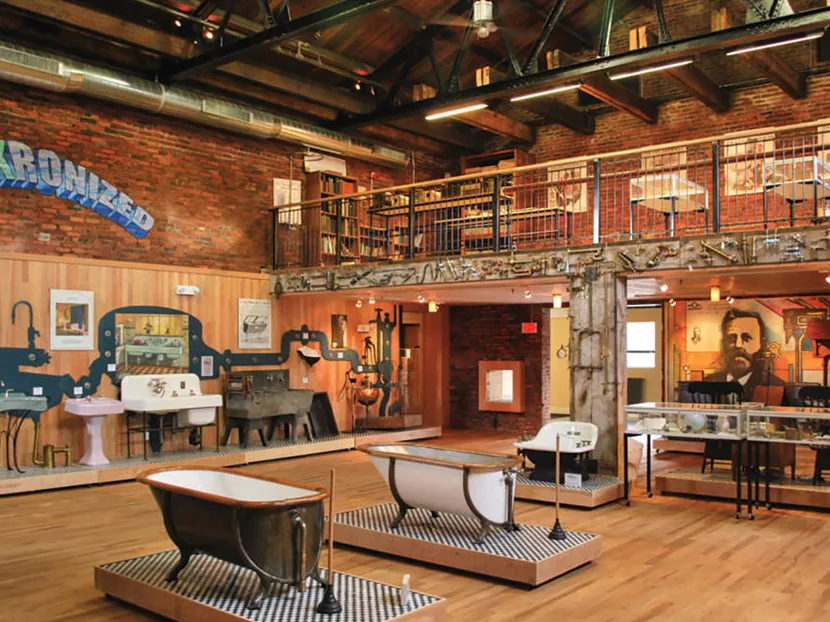How could there not be? We first visited the Plumbing Museum at some point in the 1990s when it was located at its original site in Worcester, Massachusetts.
The American Sanitary Plumbing Museum, as it was known then, traced its start to the 1950s when Charles Manoog began collecting antique commodes, claw-foot tubs, ornate sinks and other plumbing items.
Often times, the collection came to him. Manoog, who founded Manoog Supply in 1927 in Worcester, was well known in the industry as a man interested in plumbing artifacts. If a local plumber took out a customer’s old toilet to install a new one, chances are he gave the vintage model to Manoog.
His collection went even further back in time. Eventually, he had a “cast iron pan closet,” circa 1830, which, lacking an effective way to clean the pan itself, was one of the earliest and least sanitary receptacles. A very relative step-up was the “earth closet,” circa 1860, a primitive contraption that used ash and dirt to not so much dispose of waste, but at the very least, cover it up.
There were plenty of other treasures, too: The first dishwasher, dubbed the “Electric Sink;” an elaborate, decorative toilet from the late 19th century; a collection of wooden pipes; tools plumbers used to work on lead pipe; and a vast collection of old trade magazines, books and catalogues. And, let’s not forget the “hat bath,” in which the bather would sit in the middle of the metal bathtub, shaped like an upside-down top hat with a wide brim.
Manoog’s son, Russell, joined the family business after graduating from Harvard University and turned his dad’s personal collection into a public museum in 1979.
“For something so literally out of sight and out of mind, modern society is utterly dependent on pipes, hoses, tubs and toilets running smoothly and efficiently,” noted the popular travel website, Atlas Obscura, after a visit to the museum.
For the next several decades, Russell and his wife, Bettejane, ran the historic showcase as a tribute to plumbers, engineers and inventors whose hard work and creative spirit contributed to the betterment of society.
“Bathrooms were something that people didn’t talk about 100 or 200 years ago,” Russell told boston.com. “The outhouse was out there, and it was there to serve a need, a physical need. But today the bathroom in modern homes is probably the most, or second most, expensive part of your home. So instead of hiding it in the back of the house, it’s right in front. It has gained a prominence.”
New home
Even after selling the family plumbing supply business in 2004, Russell and Bettejane, continued to keep the museum open.
By 2007, however, the curators, both in their 70s, started looking for a new home for the museum, and eventually turned over the collection to the Greater Boston Plumbing Contractors Association
John Cannistraro, president of J.C. Cannistraro, who was president of the organization at the time, had the perfect spot for this compendium of plumbing and mechanical history.
Eventually, the renamed Plumbing Museum moved into an icehouse built in 1841 that the Cannistraro company had purchased in 1984 adjacent to their Watertown, Massachusetts headquarters. Following a renovation in 2008, the Plumbing Museum moved into about 1,000 square feet of space that had been used as office space.
A new addition to the museum is a to-scale and to-code cross section of a house that shows just how water gets to your tub, your toilet, and everywhere in between, and is so accurate that plumbing apprentices often use it as a study tool.
There are also nods to the present including new models of toilets from Kohler and Toto.
One fun item we don’t recall seeing is a replica of probably the most famous urinal of all time. In 1917, artist Marcel Duchamp took a porcelain urinal and rested it on the side that fastened to the wall. In 2004, a number of British art world professionals voted it the most influential artwork of the 20th century.
Community outreach
The museum’s programming also includes educational tours, especially to high school students interested in careers in the trades.
It has also hosted a festival featuring one-act plays written by Massachusetts’s playwrights and inspired by the historical books, catalogs and trade journals in the museum’s collection.
Coming up next June, the museum will host the first annual WATERtown Film Fest, which will feature screenings of independent films dedicated to increasing public awareness of the environmental, social and cultural importance of water.
The company also spearheads the Manoog Family Residency Program, providing resident artists resources and support services to pursue self-directed projects. The three-month residency offers an artist studio space, full access to the Plumbing Museum’s collection, guided access to company job sites, recycled fabrication materials and The FID, and an opportunity to display their art. The idea is for the artists to create works inspired by industrial technology or water.
The beautifully restored icehouse, complete with chutes and beams and an open layout, can also be rented out for meetings and even wedding receptions.





